Intel Unveils New Low-Cost PC Platform: Apollo Lake with 14nm Goldmont Cores
by Anton Shilov on April 15, 2016 6:00 PM EST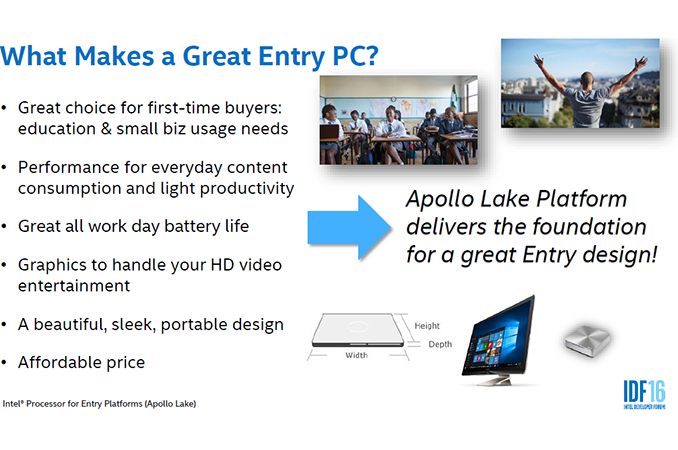
This week, at IDF Shenzhen, Intel has formally introduced its Apollo Lake platform for the next generation of Atom-based notebook SoCs. The platform will feature a new x86 microarchitecture as well as a new-generation graphics core for increased performance. Intel’s Apollo Lake is aimed at affordable all-in-ones, miniature PCs, hybrid devices, notebooks and tablet PCs in the second half of this year.
The Apollo Lake system-on-chips for PCs are based on the new Atom-based x86 microarchitecture, named Goldmont, as well as a new graphics core that features Intel’s ninth-generation architecture (Gen9) which is currently used in Skylake processors. Intel claims that due to microarchitectural enhancements the new SoCs will be faster in general-purpose tasks, but at this stage Intel has not quantified the improvements. The new graphics core is listed as being more powerful (most likely due to both better architecture and a higher count of execution units), but will also integrate more codecs, enabling hardware-accelerated playback of 4K video from hardware decoding of HEVC and VP9 codecs. The SoCs will support dual-channel DDR4, DDR3L and LPDDR3/4 memory, which will help PC makers to choose DRAM based on performance and costs. As for storage, the Apollo Lake will support traditional SATA drives, PCIe x4 drives and eMMC 5.0 options to appeal to all types of form-factors. When it comes to I/O, Intel proposes to use USB Type-C along with wireless technologies with Apollo Lake-powered systems.
| Comparison of Intel's Entry-Level PC and Tablet Platforms | ||||||
| Bay Trail | Braswell | Cherry Trail | Apollo Lake | |||
| Microarchitecture | Silvermont | Airmont | Airmont | Goldmont | ||
| SoC Code-Name | Valleyview | Braswell | Cherryview | unknown | ||
| Core Count | Up to 4 | |||||
| Graphics Architecture | Gen 7 | Gen8 | Gen8 | Gen9 | ||
| EU Count | unknown | 16 | 12/16 | unknown (24?) | ||
| Multimedia Codecs | MPEG-2 MPEG-4 AVC VC-1 WMV9 HEVC (software only) VP9 (software only) |
MPEG-2 MPEG-4 AVC VC-1 WMV9 HEVC (8-bit software/hybrid) VP9 (software/hybrid) |
MPEG-2 MPEG-4 AVC VC-1 WMV9 HEVC VP9 |
|||
| Process Technology | 22 nm | 14 nm | 14 nm | 14 nm | ||
| Launch | Q1 2014 | H1 2015 | 2015 | H2 2016 | ||
From the IDF presentation, Intel shares only a few brief details regarding its new Apollo Lake design platform, but does not disclose exact specifications or performance numbers. At this point, based on 14nm Airmont designs, it is pretty safe to assume that the new SoCs will contain up to four Goldmont cores in consumer devices but perhaps 8+ in communications and embedded systems. Intel has not specified the TDP of its new processors but claims that power management features of the platform will help it to improve battery life compared to previous-gen systems (which might point to a Speed Shift like arrangement similar to what we see on Skylake, perhaps). While Intel does not reveal specifics of its own SoCs, the company shares its vision for the upcoming PCs powered by the Apollo Lake platform.
Firstly, Intel believes that the upcoming affordable PCs, whether these are all-in-one desktops, miniature systems, 2-in-1 hybrids, laptops or tablets, should be very thin. According to their market research, this will make the devices more attractive to the buyer, which is important. To make systems thinner, Intel traditionally proposes to use either M.2 or solder-down eMMC solid-state storage options instead of 2.5” HDDs/SSDs. In addition, the company believes that it makes sense to use solder-down Wi-Fi, instead of using a separate module. Intel seems to be especially proud with the compactness of the Apollo Lake SoC (as well as other core components) and thus the whole platform, which is another factor that will help to make upcoming systems thinner. For the first time in recent years, Intel also proposes the use of smaller batteries, but devices can maintain long battery life by cutting the power consumption of the entire platform. While in many cases reduction of battery size makes sense, it should be noted that high-resolution displays typically consume a lot of energy, which is why it is hard to reduce the size of batteries, but maintain the visual experience along with a long battery life.
Secondly, PCs based on the Apollo Lake should be very affordable, which is why Intel’s reference core components design can be used for different form-factors (AiO and mobile). Additionally, the company reveals a number of BOM (bill of materials) savings opportunities, which are a result of higher level of SoC integration as well as a recommended choice of components. In the slide above, using all the savings can make a difference in BOM for between $5.55 and $7.35, which could mean double memory or a better display for the same price for the new generation.
Intel’s reference design for Apollo Lake-based PCs seems to be a tablet/2-in-1 hybrid system with an 11.6” full-HD (1920x1080) 10-point multi-touch display, 4 GB of LPDDR3-1866 memory, 64 GB M.2 SATA3 SSD or 32 GB eMMC storage, an M.2 wireless module supporting 802.11ac, an optional M.2 LTE modem, an integrated USB 2 camera, a host of sensors (accelerometer, ambient light, proximity detection, and magnetic switching) as well as a USB Type-C connector supporting USB power delivery and alternate modes. Such reference design can power not only mobile, but also Aan IO and even small form-factor desktop PCs. Still, given the fact that we are talking about low-cost systems, do not expect retail computers to feature multiple storage devices and LTE modems. However, PC makers may opt for more advanced displays as well as better integrated cameras, or an SI might plump for a half-price 'Macbook-like' device design using Type-C, albeit on the Atom microarchitecture. This is Intel's vision forthe next generation of Chromebooks: the 'cloud book' market.
PCs based on Intel’s Apollo Lake platforms will emerge in the second half of the year and will carry Celeron and Pentium-branded processors. At present, entry-level notebooks (which Intel calls Cloudbooks) offer 2 GB of memory, 32 GB of storage, 8+ hours of battery life and ~18mm thick designs. With Apollo Lake, OEMs should be able to increase the amount of RAM and/or storage capacity, make systems generally thinner, but maintain their $169 - $269 price-points. Intel also believes that its Apollo Lake presents great opportunities to build 2-in-1 hybrid PCs (convertibles) and capitalize on higher margins of such systems.
Traditionally, Intel discusses options and its vision, but not actual PCs, at its IDF trade-shows. It remains to be seen whether PC makers decide to build low-cost convertibles or ultra-thin notebook designs, or will stick to more traditional clamshell notebooks. In fact, we will learn more about BTS (back-to-school) plans of major PC OEMs regarding Apollo Lake at the upcoming Computex trade-show in early June. There's also IDF San Francisco in August where Intel may open some lids on how the new Goldmont core differs from Airmont.
Source: Intel


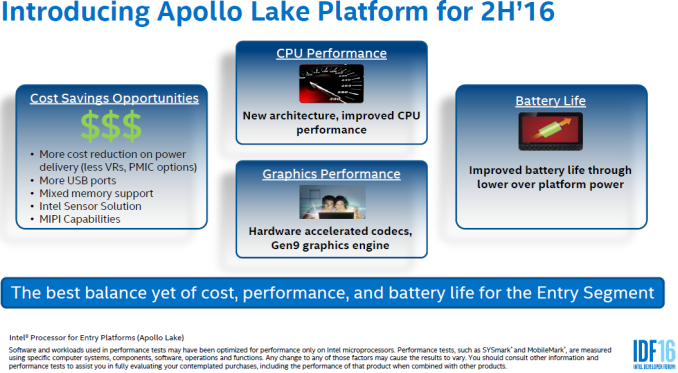
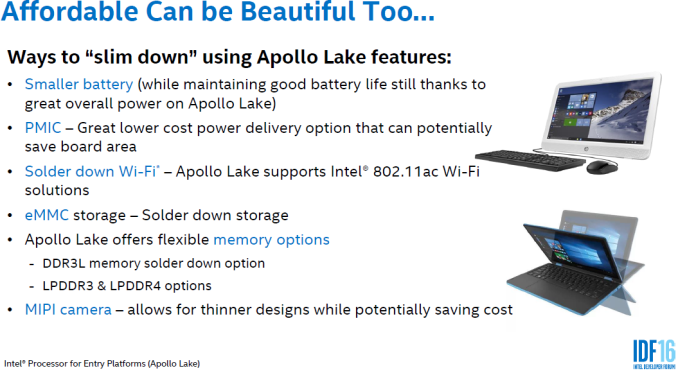
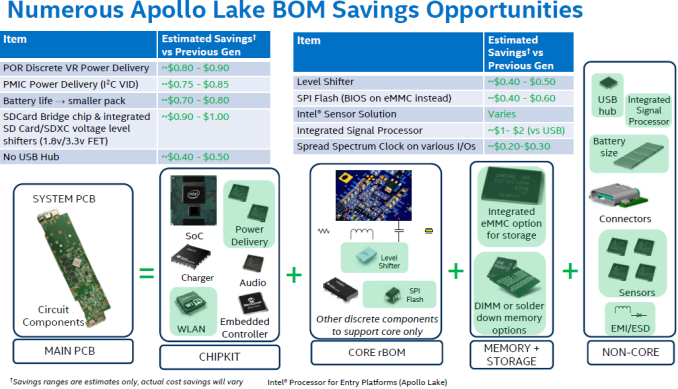
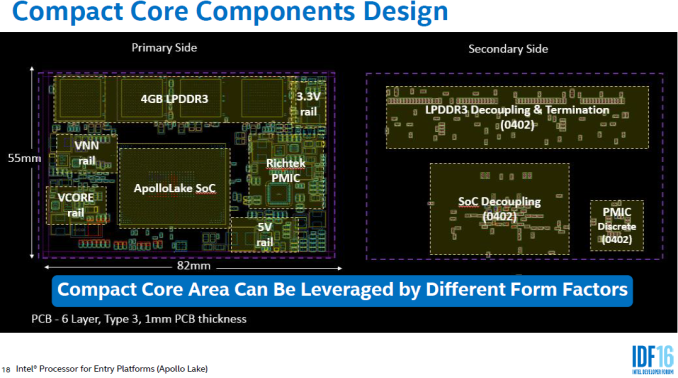
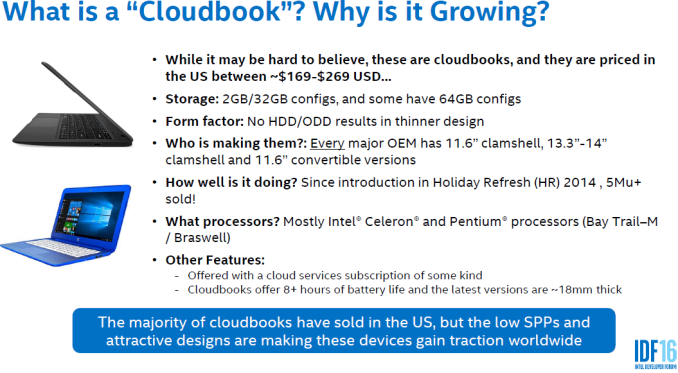
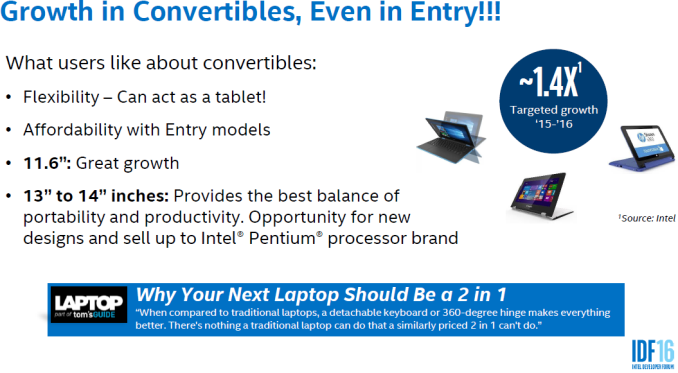














95 Comments
View All Comments
BurntMyBacon - Monday, April 18, 2016 - link
@name99: "(a) imposes a COMPLEXITY barrier. To design a performant x86 CPU seems to take 1.5 to 2x as long as designing an equivalent RISC CPU (POWER, SPARC, ARM, I don't care). We have two pieces of evidence for this:- we know how long it takes to design Intel CPUs, and we have a pretty good idea how long it takes to design their competitors
- we've had AMD say words to this effect when asked why they were considering designing an ARM server chip"
I believe this is the crux of the issue. I'm going to ignore POWER and SPARC as you haven't presented any data on their development cycles and by all appearances they seem to have similarly long cycles to Intel. Focusing in on ARM, you compare a four year cycle to a 7 or possibly 8 year cycle. I do agree that ARM designs do in practice take less time to come to market, but we should note three important considerations. 1) It is much easier to complete a SoC design when you can take core design that has already reached layout and insert it into your design. 2) The 4 year figure was for an A15 design if I recall correctly (you didn't specify). As design complexity goes up, so will development time. Consider the time it took for nVidia to develop Denver, AMD to design Seattle, and, more importantly, how long it took Qualcomm to develop Kryo. 3) Your comparison is a tiny, relatively simplistic, in-order, short pipe design (ARM) and a massive, complex, out-of-order, long pipe design (Nahalem). It should be expected that such a chip will take longer to develop. I'd compare to how long it took to design Atom. Seems to me that they've spent much more time on the SoC portion of the chip lately than the core.
@name99: "(b) the use of a more-or-less identical instruction set for Intel's low-end as their high-end means that it is OBVIOUS that the low-end will compete against the high-end."
There are pros and cons to changing the ISA and there are plenty of opinions to go around so I'll leave mine out. Putting the ISA aside, I agree that how Intel handled their product segmentation is largely responsible for the situation they're in.
There does seem to be a misunderstanding of the way Intel's processors are designed. The early stages of the processor are responsible for fetching instructions and decoding them from x86 into micro-operations (RISC type instructions). After this point, x86 is no longer relevant to the design. Back when AMD was still trying to steal Intel's lunch, this accounted for a little less than 10% of the transistors in the processor. Given that the decode logic is a fixed quantity, it's percentage and overall contribution lessen every process improvement. I think it is 2% (4% on atom sized chips) today. The point is, the chip isn't complex because it is x86, it is complex because that is how Intel designed it.
If Intel went the ARM route, they wouldn't buy an ARM core (you seem to agree with this). Their fabs are too expensive to just slap out a standard design anyways. They would likely start by replacing the x86 decode logic with ARM decode logic making any minor adjustments necessary to the micro-operation handling and leverage as much of their past work as possible. They could if they wanted fab a seriously high end server chip based on their core architecture and their low end design would likely be base on the Atom architecture. Consequently, their time to market would not change much.
The bigger question is what all this complexity buys them. Compared to ARM standard designs, the cores are much larger with much better IPCs and much more complex power saving features. ARM has chosen the simpler route of designing two cores (one performance, one low power) and letting software choose between them. Intel has chosen to design a single core that can act as both. While you can argue that it is hard to do both well, having at something like twice the transistor budget per core has its own benefits. Interestingly, Apple and Qualcomm both seem to be moving towards fewer, larger cores as well.
extide - Monday, April 18, 2016 - link
Dude this has NOTHING to do with the ISA. See A53, A57, etc. There are high end and low end ARM cpu's as well. Also, a "high end ARM CPU takes only 4 years" well -- those high end cpu's are basically only competitive with Atom ANYWAYS! The ISA only really matters to the front end and instruction decoders on the CPU, Much of the back end/execution side is all the same, regardless of the ISA, so really you have no idea what you're talking about.jasonelmore - Saturday, April 16, 2016 - link
This, Until Intel gets serious about making LTE modems and integrating them into their Tablet Soc's, then everyone will choose a Snapdragon chip that has the modem already built in. Even qualcom's fee's MSRP LTE Fee plus soc, is less than what intel will charge for this platform which has no LTErahvin - Tuesday, April 19, 2016 - link
Intel's costs have little to do with production cost. They are trying to not undercut their other sales. They are in a sticky situation. They could wipe ARM sales out if they wanted to but they'd have to annihilate their own high end sales margins to do it. So they try to balance power at the low end so they don't erode their margins on the high end. The result is they aren't very competitive on the low end, but this isn't because they can't be. It's strictly because they don't want to erode their margins.zodiacfml - Saturday, April 16, 2016 - link
Yep, partly right and wrong. The only mistake Intel did was to consider Atom as second class in terms of getting the latest process nodes. It is only recently they realized which is too late now as smartphones got their performance to a level of good enough.hrrmph - Saturday, April 16, 2016 - link
No, the other folks have it correct, it was the lack of (and continuing lack of) integration. You could put it on the best process node in the world every time, but without LTE it is still only second best.name99 - Sunday, April 17, 2016 - link
And yet that is EXACTLY what Apple ships...As far as I know, Kirin (Huawei's SoCs) also come without on-board LTE. Likewise Exynos (Samsung's SoCs).
Rockchip, of course, does ship integrated LTE, in their SoFIA line. How do they do that? By using INTEL's modem!
Pretty much every aspect of this claim (Intel was doomed to failure in mobile because they had no cellular basedband to integrate onto their parts) is false.
Strunf - Monday, April 18, 2016 - link
Apple is not relevant in this context, they make their own phones and design their own chips, it's not like their SOC were competing against any other SOC.MediaTek SOC have LTE, the new Exynos have it, the Snapdragons have it... most if not all SOC with ARMv8 probably have LTE and other options. All of them can provide a more complete solution than Intel can, and this probably at a lower cost.
BurntMyBacon - Monday, April 18, 2016 - link
@Strunf: "Apple is not relevant in this context, ..."Except that it is possible (as name99 said) that they will be using Intel's LTE modem for their A10.
@Strunf: "MediaTek SOC have LTE, the new Exynos have it, the Snapdragons have it... most if not all SOC with ARMv8 probably have LTE and other options. All of them can provide a more complete solution than Intel can ..."
Huawei's Kirin has seem more market penetration than Intel's Atoms. They don't have a modem either. I'm pretty sure Intel also has the stronger brand name, so there must be another reason.
@Strunf: "... probably at a lower cost."
That's the one. In a cutthroat market with low margins that is approaching saturation, you have to present a compelling reason for people to spend more. From an objective look at benchmarks, Intel has good core performance, but the end user experience is largely the same as their lower cost competitors.
Namisecond - Monday, April 18, 2016 - link
Processors, on the desktop at least, got good enough around Sandy Bridge. Blame it on the SSDs for freeing up the IO bottleneck and making a 6 year old PC better than a recent pc with a HDD.